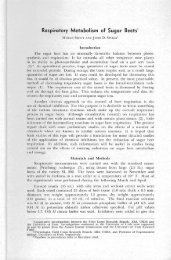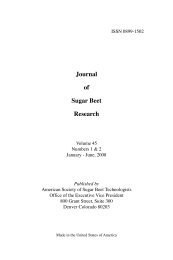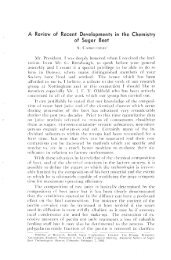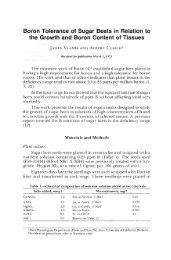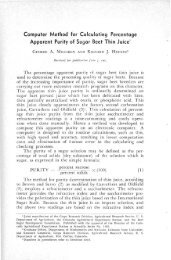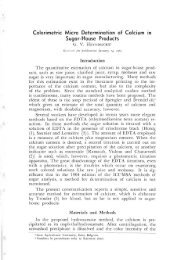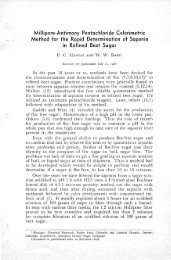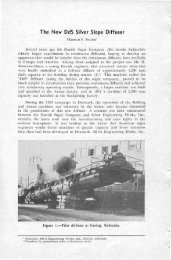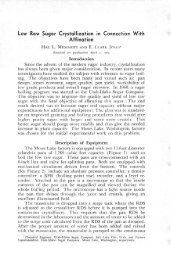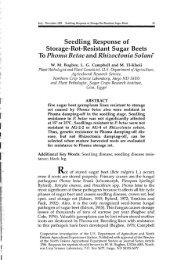Seed-borne Phoma betae as Influenced by Area of Sugarbeet ... - Vol
Seed-borne Phoma betae as Influenced by Area of Sugarbeet ... - Vol
Seed-borne Phoma betae as Influenced by Area of Sugarbeet ... - Vol
You also want an ePaper? Increase the reach of your titles
YUMPU automatically turns print PDFs into web optimized ePapers that Google loves.
<strong>Seed</strong>-<strong>borne</strong> <strong>Phoma</strong> <strong>betae</strong> <strong>as</strong> <strong>Influenced</strong> <strong>by</strong><br />
<strong>Area</strong> <strong>of</strong> <strong>Sugarbeet</strong> Production, <strong>Seed</strong><br />
Processing and Fungicidal <strong>Seed</strong> Treatments<br />
L. D. LEACH and J. D. MACDoNALD!<br />
Received for publication December 19, 1975<br />
Introduction<br />
The only important seed-<strong>borne</strong> pathogen <strong>of</strong>sugarbeet seedlings is<br />
<strong>Phoma</strong> <strong>betae</strong> (Oud.) Fr., [ =Pleospora bjoerlingii Byford.]. Other seedling<br />
dise<strong>as</strong>es are caused <strong>by</strong> soil inhabiting fungi such <strong>as</strong>: Aphanomyces<br />
cochlioides Drechs., Pythium ultimum Trow, P. debaryanum Hesse, P.<br />
aphanidermatum (Edson) Fitzp. or Rhizoctonia solani Kuhn<br />
[ = Thanatephorus cucumeris (Frank) Donk.]<br />
In Europe, the excellent survey <strong>by</strong> Dunning (6)2 in 1972 showed<br />
that plant pathologists in 13 countriesbelieved that the most important<br />
seedling pathogen <strong>of</strong> sugarbeets w<strong>as</strong> <strong>Phoma</strong> <strong>betae</strong> and that seed treatments<br />
effective against this pathogen were indispensible. In the United<br />
States, however, our experience h<strong>as</strong> been less consistent. Prior to the<br />
1930s when most <strong>of</strong> our seed w<strong>as</strong> imported from Europe, <strong>Phoma</strong><br />
seedling dise<strong>as</strong>e w<strong>as</strong> quite serious and mercury seed treatments were<br />
commonly used <strong>as</strong> the only effective means <strong>of</strong> control. With the initiation<br />
<strong>of</strong> domestic seed production in the arid southwest, sugarbeet seed<br />
w<strong>as</strong> found to be essentially free from <strong>Phoma</strong> (8, 9), thus allowing<br />
attention to be focused on the soil-<strong>borne</strong> seedling pathogens. The use<br />
<strong>of</strong> mercury seed treatments w<strong>as</strong> discontinued and newer, <strong>of</strong>ten selective<br />
fungicidal seed treatments were substituted to protect seedlings<br />
against the other pathogens. However, when domestic seed production<br />
w<strong>as</strong> later shifted to Oregon for the production <strong>of</strong> non-bolting<br />
varieties, some seed lots were again found to carry considerab1e<strong>Phoma</strong><br />
(10). This w<strong>as</strong> cause for some concern <strong>as</strong> the protective seed treatments<br />
which had come into use were only partially effective against <strong>Phoma</strong><br />
and the industry preferred not to return to the use <strong>of</strong> mercury treatments.<br />
1 Pr<strong>of</strong>essor Emeritus and Research Assistant, respectively, Department <strong>of</strong> Plant Pathology, University<br />
<strong>of</strong>California, Davis, CA 95616. The writers thank Carol Frate, research <strong>as</strong>sistant, for help with<br />
part <strong>of</strong> the laboratory and greenhouse trials; A. A. M<strong>as</strong>t, Western <strong>Seed</strong> Production Company,<br />
Phoenix, Arizona, Sam Campbell, West Co<strong>as</strong>t Beet <strong>Seed</strong> Co., Salem, Oregon, Frank R. Low, British<br />
Columbia Sugar Refining Company, Vancouver, B. C., and C. K. Comerford, Irish Sugar Co.,<br />
Dublin, Ireland for seed samples from Oregon, Arizona, British Columbia and Europe, respectively;<br />
and the California <strong>Sugarbeet</strong> Growers and Processors for financial <strong>as</strong>sistance.<br />
2Numbers in parentheses refer to literature cited.
(<br />
VOL. 19, No.1, MARCH 1976<br />
In Oregon, the seed crops are planted in August or early September<br />
and sprinkler-irrigated until the fall rains begin. <strong>Phoma</strong> first<br />
appears to a. limited extent in the fall, <strong>as</strong> seedling or leaf spot infections,<br />
and persists through the winter <strong>as</strong> infections on leaf or crown<br />
tissue. With spring growth and bolting, leaf spots, crown infections,<br />
and later, lesions on the seed stalks appear. During periods <strong>of</strong> rainfall<br />
or high humidity, pycnidia <strong>of</strong> the fungus exude spores in gelatinous<br />
m<strong>as</strong>ses. These spores are readily spread <strong>by</strong> spl<strong>as</strong>hing rain or overhead<br />
sprinklers or, when dry, may become air-<strong>borne</strong> and <strong>by</strong> these means<br />
come into contact with developing floral parts and result in seed<br />
infection. The most important period in terms <strong>of</strong> seed infection, however,<br />
appears to occur during the harvest period. When the seed is<br />
ready to harvest, the seed stalks are cut, swathed and allowed to cure in<br />
the field for a period <strong>of</strong> 10 to 20 days before the actual threshing <strong>of</strong> the<br />
seed. I f rainfall occurs during this period it further stimulates sporulation<br />
<strong>of</strong> the pycnidia and e<strong>as</strong>ily spreads <strong>Phoma</strong> spores to the seed where<br />
they may germinate and invade tissues <strong>of</strong> the seed units.<br />
Because <strong>Phoma</strong> again appeared to be becoming a problem, and<br />
since the earlier work with seed-<strong>borne</strong> <strong>Phoma</strong> had involved European<br />
or the older domestic multigerm varieties, it w<strong>as</strong> felt that a reevaluation<br />
<strong>of</strong> the <strong>Phoma</strong> problem w<strong>as</strong> desirable using current<br />
monogerm seed. The objectives <strong>of</strong> this study were to identify the<br />
climatic factors <strong>as</strong>sociated with seed infection, to determine the effects<br />
<strong>of</strong>commercial seed processing on the levels <strong>of</strong>seed transmission, and to<br />
compare the effectiveness <strong>of</strong> protective fungicidal seed treatments on<br />
seed lots with different levels <strong>of</strong> infestation.<br />
Determination <strong>of</strong> <strong>Seed</strong> Infection<br />
Evaluation <strong>of</strong> the amount <strong>of</strong> <strong>Phoma</strong> carried on beet seed w<strong>as</strong><br />
determined <strong>by</strong> both laboratory and greenhouse trials. There are three<br />
general laboratory methods for determining the percentage <strong>of</strong> seeds<br />
carrying <strong>Phoma</strong>.<br />
1. Blotter method - Blotters <strong>of</strong> the type used in determin;ltions <strong>of</strong><br />
seed germination are soaked, drained and placed in petri dishes. Five<br />
seed units are placed in each dish and incubated for 7 days at 20°C with<br />
a cycle <strong>of</strong> 12 hours <strong>of</strong> darkness and 12 hours <strong>of</strong> near ultraviolet light.<br />
After incubation the seeds and seedlings are examined with enlargement<br />
<strong>of</strong> 20 to 50 times for pycnidia <strong>of</strong> P. <strong>betae</strong>.<br />
2. Potato dextrose agar method - PDA is poured into petri dishes at<br />
approximately 15 ml per dish. Five seed units are placed in each dish,<br />
incubated for 7 days at 20° in a cycle <strong>of</strong> 12 hours darkness and 12 hours<br />
<strong>of</strong> near ultraviolet light. After incubation, all seeds, seedlings and<br />
fungal colonies are examined at 20-50x magnification for pycnidia <strong>of</strong><br />
P. <strong>betae</strong>. <strong>Seed</strong> analysts usually prefer the PDA method because it is less<br />
time consuming with large numbers <strong>of</strong> samples. Unfortunately, with<br />
5
6 jOUR;\;AL OF THE A. S. S. B. T.<br />
some seed lots, contaminating saprophytic fungi may seriously interfere<br />
with accurate identification.<br />
3. Water agar method - Water agar 0.2%) is poured into pl<strong>as</strong>tic<br />
petri dishes in a shallow layer. Five to 7 seed units are placed in each<br />
dish and incubated for 7 days at 20°C. The dishes are inverted and<br />
examined at the level <strong>of</strong>agar contact with the bottom <strong>of</strong>the dish for the<br />
presence <strong>of</strong>"holdf<strong>as</strong>ts" <strong>as</strong> described <strong>by</strong> Mangan (11, 12). Magnification<br />
<strong>of</strong>50-1 00 times is used for observation. To retard seed germination 50<br />
ppm <strong>of</strong> 2,4-D may be added to the water agar (12). Bugbee (1) recently<br />
reported that the use <strong>of</strong> a selective medium containing boron induced<br />
the holdf<strong>as</strong>ts to turn dark brown to black so they could be observed<br />
with the naked eye or a lOx hand lens.<br />
The water agar method usually gives the highest readings, especially<br />
in the presence <strong>of</strong> contaminating fungi, and for this re<strong>as</strong>on w<strong>as</strong><br />
felt the most desirable for use in this study. Additional information on<br />
seed infection can be secured with either the PDA or water agar<br />
methods <strong>by</strong> pretreating part <strong>of</strong> the seeds from each lot in NaOCI. A<br />
pretreatment consisting <strong>of</strong> a 5-minute immersion in 0.5% NaOCI w<strong>as</strong><br />
used throughout this study, although European workers favor<br />
10-minute treatments in 1.0% solutions for more heavily contaminated<br />
seed. Examination <strong>of</strong> seeds plated without disinfestation indicates the<br />
total number contaminated <strong>by</strong> <strong>Phoma</strong>, while similar observations <strong>of</strong><br />
disinfested seeds indicate the amount <strong>of</strong> deep penetration <strong>of</strong> <strong>Phoma</strong><br />
into the seed tissues. In the present study, 50 seeds from each seed<br />
sample were plated on water agar following disinfestation, and 50 were<br />
plated without disinfestation.<br />
The ability <strong>of</strong>seed-<strong>borne</strong><strong>Phoma</strong> to in fect seedlings w<strong>as</strong> studied in a<br />
series <strong>of</strong> greenhouse trials, where 150 untreated seeds from each<br />
sample were planted in moist p<strong>as</strong>teurized soil and maintained in<br />
growth chambers at approximately 12°C for 28 days. Young seedlings<br />
which exhibited damping-<strong>of</strong>f symptoms were removed from the soil,<br />
plated on water agar and observed for the characteristic holdf<strong>as</strong>ts to<br />
confirm <strong>Phoma</strong> infection. At the end <strong>of</strong> the experiment aU seedlings<br />
were lifted, w<strong>as</strong>hed, and examined for lesions on root or hypocotyl<br />
tissue. All seedlings suspected <strong>of</strong> infection were plated on water agar to<br />
confirm the presence <strong>of</strong> <strong>Phoma</strong>. In addition, approximately 20 seedlings<br />
without lesions were plated to check for incipient infections but no<br />
<strong>Phoma</strong> colonies were found.<br />
Using both laboratory and greenhouse methods we have evaluated<br />
over 100 seed lots from the United States, Canada, and several<br />
European countries. Rather than cl<strong>as</strong>sifying sugarbeet seed lots solely<br />
on the percentage <strong>of</strong> seed units carrying P. <strong>betae</strong>, the results have led<br />
us to propose a system <strong>of</strong> cl<strong>as</strong>sification which recognizes four b<strong>as</strong>ic<br />
infection types and appears to better describe the <strong>as</strong>sociation <strong>of</strong> P.<br />
<strong>betae</strong> with sugarbeet seed.
VOL. 19, No.1, MARCH 1976<br />
Type A. Little «5%) or no<strong>Phoma</strong> present on the seeds <strong>as</strong> me<strong>as</strong>ured<br />
<strong>by</strong> laboratory and greenhouse trials.<br />
Type B. <strong>Phoma</strong> present on a moderate percentage <strong>of</strong> the seeds<br />
(5-20%) but mostly superficial <strong>as</strong> shown <strong>by</strong> its e<strong>as</strong>y removal with the<br />
NaOCI treatment. Causes little or no seedling dise<strong>as</strong>e in greenhouse<br />
plantings.<br />
Type C. Moderate to high degree <strong>of</strong>contamination (30-60%) which<br />
is reduced but not eliminated <strong>by</strong> NaOCI treatment. Causes a moderate<br />
amount (20-40%) <strong>of</strong> seedling dise<strong>as</strong>e in soil trials.<br />
Type D. <strong>Seed</strong>s heavily infected (>60%) with only slight reduction<br />
following NaOCI treatment. Causes fairly high amounts (>40%) <strong>of</strong><br />
seedling dise<strong>as</strong>e.<br />
Influence <strong>of</strong> Rainfall on <strong>Seed</strong> Infection Type<br />
The relation <strong>of</strong> climatic factors to contamination or infection <strong>of</strong><br />
sugarbeet seed <strong>by</strong> P. <strong>betae</strong> is illustrated <strong>by</strong> the results <strong>of</strong> laboratory and<br />
soil germination trials with seed lots from different climatic are<strong>as</strong> and<br />
with seed lots produced in the same area but in different years. Table 1<br />
shows the results <strong>of</strong>analyses <strong>of</strong>seed lots produced in 3 are<strong>as</strong> <strong>of</strong>western<br />
North America.<br />
Table 1. - Relation <strong>of</strong> precipitation to <strong>Phoma</strong> infection <strong>of</strong> sugarbeet seedwestern<br />
North America.<br />
Precipitation (mm) <strong>Phoma</strong> Infection (%) Inf.<br />
<strong>Seed</strong> Days before harvest Water Agar Soil Type<br />
Grown 31-60 1-30 Harv. Total Untr. NaOCl a Sd!. Inf. (A-D)<br />
Arizona<br />
1970 8 3 2 13 0 0 A<br />
Medford,<br />
Oregon<br />
1971 33 3 0 36 23 < 1 1 B<br />
1972 40 tr. 0 40 18 1 4 B<br />
British<br />
Columbia<br />
1967 12 22 20 54 1 1 5 A<br />
1968 42 26 53 121 68 :31 37 C-D<br />
1972 81 21 6 109 3H 16 9 B-C<br />
apretreatment - 0.5 % NaOCI for 5 min.<br />
The Phoenix area <strong>of</strong> Arizona is almost rain-free during May and<br />
June when beet seed is maturing and being harvested. Laboratory tests<br />
with 4 seed lots produced in 1970 showed no<strong>Phoma</strong> on any <strong>of</strong>the seeds,<br />
so they were cl<strong>as</strong>sified <strong>as</strong> type A seeds. Because <strong>of</strong>the mild winters only<br />
beet varieties <strong>of</strong> e<strong>as</strong>y or moderate bolting tendencies can be reproduced<br />
in the Phoenix area.<br />
The Medford area <strong>of</strong> Oregon, where harder bolting varieties are<br />
produced, h<strong>as</strong> considerable rainfall during the winter but very little<br />
7
8 JOU RNAL OF THE A. S. S. B. T.<br />
during July and August when beet seed is maturing and being harvested.<br />
During 1971 and 1972 the seed lots tested showed about 20%<br />
<strong>Phoma</strong> contamination, which w<strong>as</strong> probably <strong>as</strong>sociated with the early<br />
rainfall. Very little penetration <strong>of</strong> the seed units occurred, <strong>as</strong> shown <strong>by</strong><br />
inoculum reduction following NaOCI disinfestation and <strong>by</strong> a very low<br />
percentage <strong>of</strong> seedling infection. This seed w<strong>as</strong> cl<strong>as</strong>sified <strong>as</strong> having a<br />
grade B infection type.<br />
In the Puget Sound area <strong>of</strong> British Columbia the results in 3<br />
se<strong>as</strong>ons were quite variable. In 1967 there w<strong>as</strong> little rainfall before or<br />
during harvest and very little <strong>Phoma</strong> w<strong>as</strong> found on the seed samples. In<br />
soil 5% <strong>of</strong> the seedlings showed <strong>Phoma</strong> infection, which w<strong>as</strong> more than<br />
would be expected from the laboratory tests. In 1968 there were fairly<br />
heavy rains, especially late during the harvest period, and the seed lots<br />
showed high counts <strong>of</strong> <strong>Phoma</strong> on the seed and fairly high seedling<br />
infection. In 1972 most <strong>of</strong> the rain fell early duringJune and very little<br />
during the harvest period. The result w<strong>as</strong> seed lots with a moderate<br />
amount <strong>of</strong><strong>Phoma</strong> contamination on seed, which w<strong>as</strong> much reduced <strong>by</strong><br />
disinfestation treatments, and fairly low seedling infection. The British<br />
Columbia seed w<strong>as</strong> cl<strong>as</strong>sified <strong>as</strong> type A in 1967, C-D in 1968 and B-C in<br />
1972.<br />
Similar information w<strong>as</strong> compiled for seed lots produced during 2<br />
years in Italy, France, and Ireland, and is reported in Table 2.<br />
Table 2. - Relation <strong>of</strong> precipitation to <strong>Phoma</strong> infection <strong>of</strong> sugarbeet seed-<br />
Europe.<br />
Precipitation a (mm) <strong>Phoma</strong> Infection (%) Inf.<br />
<strong>Seed</strong> Days before harvest Water Agar Soil Type<br />
Grown 31-60 1-30 Harv. Total Untr. NaOCl b Sdl. Inf. (A-D)<br />
Italy<br />
1969<br />
1970<br />
France<br />
1969<br />
1970<br />
Ireland<br />
1968<br />
1970<br />
21<br />
52<br />
79<br />
69<br />
60<br />
97<br />
57<br />
27<br />
51<br />
95<br />
61<br />
58<br />
46<br />
20<br />
30<br />
13<br />
149<br />
101<br />
124<br />
99<br />
160<br />
177<br />
270<br />
256<br />
13<br />
15<br />
47<br />
37<br />
20<br />
15<br />
90 70<br />
62<br />
8<br />
7<br />
21<br />
33 •<br />
aprecipitation data provided <strong>by</strong> C. Comerford, Irish Sugar Company, Dublin,<br />
Ireland.<br />
bpretreatment - 1% NaOCI for 10 min. Laboratory tests <strong>by</strong> A. Mangan, Dublin, Ireland.<br />
In the area <strong>of</strong> seed production along the Adriatic co<strong>as</strong>t in Italy,<br />
light rainfall occurred during the 60 days preceding harvest and also<br />
during the harvest period in 1969 and 1970. The seed lots produced in<br />
each year carried a low percentage <strong>of</strong><strong>Phoma</strong> contamination which w<strong>as</strong><br />
apparently superficial, since it w<strong>as</strong> effectively removed <strong>by</strong> a NaOCI<br />
treatment. Less than 10% <strong>of</strong> the seedlings from nontreated seed in<br />
70<br />
73<br />
B<br />
B<br />
C<br />
C<br />
D<br />
D
VOL. 19, No.1, MARCH 1976<br />
p<strong>as</strong>teurized soil were infected <strong>by</strong> <strong>Phoma</strong> and the seed w<strong>as</strong> cl<strong>as</strong>sified <strong>as</strong><br />
type B.<br />
In the Mediterranean region <strong>of</strong> France, however, there w<strong>as</strong> considerably<br />
more rainfall than in Italy, especially during the 60 days<br />
before harvest in both 1969 and 1970. The seed lots averaged 35 to<br />
50% <strong>of</strong> the seed infected <strong>by</strong> <strong>Phoma</strong>, with only about half <strong>of</strong> the inoculum<br />
removed <strong>by</strong> NaOCI treatment. <strong>Seed</strong>ling infection averaged 20<br />
to 30% and the seed w<strong>as</strong> cl<strong>as</strong>sified <strong>as</strong> type C.<br />
In the Limerick area <strong>of</strong> Ireland there w<strong>as</strong> frequent and moderately<br />
heavy rainfall during the 60 days before and quite heavy rainfall<br />
during the harvest periods in 1968 and 1970. The seed lots carried<br />
high percentages 0 <strong>Phoma</strong>, which penetrated deeply into the seed<br />
units and produced high percentages <strong>of</strong>seedling infection. In contr<strong>as</strong>t<br />
to other European seed lots, those produced in Ireland in 1968 and<br />
1970 were typical <strong>of</strong> infection type D.<br />
A more detailed study w<strong>as</strong> made <strong>of</strong> seed lots produced in the<br />
Willamette Valley <strong>of</strong> Oregon because most <strong>of</strong> the beet seed used in<br />
western United States comes from that area. Several seed lots were<br />
analyzed from each year's production from 1967 to 1973, with the seed<br />
from two years (1971 and 1973), part <strong>of</strong> which w<strong>as</strong> harvested before<br />
and part after a heavy harvest rain, being reported separately.<br />
The resuits in Table 3 show that in 1967 and 1970 there w<strong>as</strong> very<br />
little rainfall during the 60 days before harvest or while the seed stalks<br />
were drying in the field. As a result the seed w<strong>as</strong> free or nearly free <strong>of</strong><br />
<strong>Phoma</strong> infection and cl<strong>as</strong>sified <strong>as</strong> type A seed. However, in 1969, when<br />
rain fell during the period 31-60 days before harvest, and no later, the<br />
seed lots carried only superficial<strong>Phoma</strong> infection and seedling infection<br />
w<strong>as</strong> very low, typical for seed infection type B.<br />
In contr<strong>as</strong>t, during 1968 a period <strong>of</strong> very heavy rain occurred<br />
during harvest while the seed stalks were in the swath and a high<br />
percentage <strong>of</strong> the seeds were apparently deeply infected <strong>by</strong> <strong>Phoma</strong> and<br />
resulted in high percentages <strong>of</strong>infected seedlings, indicating infection<br />
type D. An unusual situation occurred in both 1971 and 1973 in which<br />
a rain fell during the harvest period. A portion <strong>of</strong>several seed lots had<br />
been harvested before the rain and this permitted direct comparisons<br />
<strong>of</strong> the effect <strong>of</strong> the rain on subsamples <strong>of</strong> the same seed lots. Samples<br />
threshed prior to the rainy period showed moderate <strong>Phoma</strong> infection<br />
while those rained on while curing in the field showed higher infection<br />
levels.<br />
The seed lots produced in 1972 showed a surprisingly high percentage<br />
<strong>of</strong> <strong>Phoma</strong> infection in view <strong>of</strong> the very low rainfall 60 days<br />
before and during harvest. This may be accounted for <strong>by</strong> the fact that<br />
all Willamette Valley seed fields are irrigated <strong>by</strong> overhead sprinklers<br />
from late spring until approximately 30 days before the cutting <strong>of</strong>seed<br />
9
10 JOURNAL OF THE A. S. S. B. T.<br />
Table 3. - Relation <strong>of</strong> precipitation to <strong>Phoma</strong> infection <strong>of</strong> sugarbeet seed-<br />
Willamette Valley, Oregon.<br />
Year<br />
Precipitation (mm) <strong>Phoma</strong> Infection (%) Inf.<br />
Days before harvest<br />
Water Agar Soil Type<br />
31-60 1-30 Harv. a Total<br />
Untr. NaOCl b Sdl. Inf.<br />
(A-D)<br />
1967 18 0 tr. 18 9 1 2 A<br />
1968 38 10 106 e<br />
154 66 56 32 C-D<br />
1969 75 e<br />
77 24 1 1 B<br />
1970 22 1 tr. 23 0 0 0 A<br />
1971 c 78 e<br />
3 8 89 38 10 18 C<br />
1971 d<br />
78 3 86 e<br />
167 48 34 25 C-D<br />
1972 18 3 4 25 45 25 4 B-C<br />
1973 c<br />
35 tr. 0 35 33 8 B-C<br />
1973 d<br />
35 tr. 20 55 61 14 11 C<br />
aHarvest period extended from cutting <strong>of</strong> the seed stalks to threshing <strong>of</strong> the dried seed<br />
and ranged from 10 days to 30 days depending on the area and se<strong>as</strong>on. If the harvest<br />
period could not be identified, rainfall for a 30-day period w<strong>as</strong> reported.<br />
bpretreatment - 0.5% NaOCI for 5 min.<br />
(Early threshing before rainfall.<br />
dLate threshing after heavy rainfall during curing period.<br />
eRainfall events which are felt to have been important in the ultimate seed infection<br />
grade.<br />
stalks. In some years this may provide enough moisture to distribute<br />
<strong>Phoma</strong> spores and promote infection <strong>of</strong> immature seed units.<br />
Effect <strong>of</strong> <strong>Seed</strong> Processing on <strong>Phoma</strong> <strong>Seed</strong>ling Infection<br />
<strong>Seed</strong> lots carrying infection types A or B showed very few seeds<br />
carrying<strong>Phoma</strong> after disinfestation with NaOCI, indicating that most<strong>of</strong><br />
the contamination w<strong>as</strong> superficial. They also produced very few infected<br />
seedlings in greenhouse tests. <strong>Seed</strong> lots type C and D! however,<br />
carried high percentages <strong>of</strong> <strong>Phoma</strong>, with some penetration <strong>of</strong> the<br />
pathogen into seed tissues, and it w<strong>as</strong> important to learn what effects<br />
seed processing, in which superficial tissues are milled away, could<br />
have on seedling infection.<br />
Tests were run with processed and nonprocessed seed <strong>of</strong> the same<br />
lots to determine what effects processing h<strong>as</strong> on the amount <strong>of</strong> inoculum<br />
carried on seed and the efficiency <strong>of</strong> fungicidal seed treatments.<br />
The results reported in Table 4 show whole seed produced in<br />
an area with abundant summer rainfall and having 80-90% <strong>Phoma</strong><br />
infection, and cl<strong>as</strong>sified <strong>as</strong> infection type D, compared with a seed lot<br />
produced in an area with less summer rainfall and cl<strong>as</strong>sified <strong>as</strong> infection<br />
type C. Disinfestation <strong>of</strong> type D whole seed with NaOCI did not<br />
reduce the percentage <strong>of</strong> seed units showing <strong>Phoma</strong> on water agar, but
12 JOURNAL OF THE A. S. S. B. T.<br />
carrying type C infection show that even though a high percentage <strong>of</strong><br />
the seed units carry <strong>Phoma</strong>, most <strong>of</strong> the inoculum is in the superficial<br />
tissues where it can be reduced <strong>by</strong> a disinfestant and can be removed or<br />
exposed <strong>by</strong> processing so that fungistatic protectants can reduce seedling<br />
infection to a very low level.<br />
<strong>Seed</strong> Treatments<br />
For many years the standard control for <strong>Phoma</strong> seedling infection<br />
in Europe w<strong>as</strong> treatment <strong>of</strong> the seed with volatile ethyl or methyl<br />
mercury fungicides, which were applied <strong>as</strong> dusts or liquids directly<br />
onto the seeds. Similar seed treatment fungicides were also used in<br />
North America when <strong>Phoma</strong>-infected beet seeds were imported from<br />
Europe. However, because the seed lots produced in the moist climate<br />
<strong>of</strong> Ireland were heavily and deeply infected <strong>by</strong> <strong>Phoma</strong> <strong>betae</strong>, even these<br />
treatments provided only partial control. In 1951, while on a Marshall<br />
Plan <strong>as</strong>signment in Ireland, the senior author demonstrated the very<br />
effective control <strong>of</strong> seed-<strong>borne</strong> <strong>Phoma</strong> <strong>by</strong> immersing, or steeping, the<br />
seed for 20 minutes in a 40 ppm solution <strong>of</strong> ethyl mercury phosphate<br />
(EMP) with a seed/solution ratio <strong>of</strong> 1:8 on a w/w b<strong>as</strong>is (l0). This<br />
treatment w<strong>as</strong> first used commercially in Ireland in 1952 (5) and<br />
continued until 1972 when seed production w<strong>as</strong> transferred largely to<br />
the drier Mediterranean area.<br />
In 1954, Gates and Hull (7) also rer",)rted very good results with<br />
the EMP steep and since 1961 all sugarbeet seed in Great Britain h<strong>as</strong><br />
been steeped in ethyl mercury phosphate (4). In recent years, however,<br />
the use <strong>of</strong>ethyl and methyl mercury compounds <strong>as</strong> seed treatments h<strong>as</strong><br />
been discontinued in most northern European countries, and except<br />
for England, these countries have shifted their beet seed production to<br />
are<strong>as</strong> <strong>of</strong> lower summer rainfall such <strong>as</strong> Italy, France, Austria, Yugoslavia,<br />
and Turkey. At present over 90% <strong>of</strong> the sugarbeet seed used in<br />
western Europe is genetic monogerm or mechanical monogerm all <strong>of</strong><br />
which is processed <strong>by</strong> rubbing and much <strong>of</strong> which in some countries is<br />
also pelleted.<br />
The fungicides which are presently most commonly used <strong>as</strong> seed<br />
treatments in Europe are methoxyethylmercury compounds, thiram,<br />
maneb or mancozeb. In North America the most commonly used seed<br />
treatment fungicides are Dexon alone or in combination with PCNB<br />
although maneb or captan are used in some are<strong>as</strong>. These fungicides<br />
are only partially effective with seed carrying the D type <strong>of</strong> <strong>Phoma</strong><br />
infection or with unprocessed seed carrying the C type <strong>of</strong>infection but<br />
in our trials gave satisfactory control with processed seed carrying the<br />
B or C type. The effects <strong>of</strong> seed processing and seed treatment with<br />
Dexon and PCNB on the infection <strong>of</strong> sugarbeet seedlings from 4 seed<br />
lots carrying the C type <strong>of</strong> <strong>Phoma</strong> infection are presented in Table 5.<br />
In similar trials seed treatment with thiram, maneb, or TCMTB<br />
did not differ consistently or significantly from the Dexon-PCNB<br />
seed treatments.
VOL. 19, No.1, MARCH 1976<br />
Table 5. - Effect <strong>of</strong> seed processing and treating on <strong>Phoma</strong> infection <strong>of</strong><br />
sugarbeet seedlings.a<br />
Percent infection <strong>of</strong> seedlings<br />
per seed lot b<br />
<strong>Seed</strong> Treatment 2 3 4<br />
Whole None 17.Sa 41.la 42.4a 24.la<br />
Processed None 4.2b 30.9b 19.5b 10.3b<br />
Processed Dexon + PCNB l.lb I.Sc 4.2c 3.5c<br />
aAll seed lots carried the C type <strong>of</strong> <strong>Phoma</strong> infection.<br />
b I .<br />
Co umn entnes followed <strong>by</strong> the same letter do not differ significantly (P = 0.05)<br />
<strong>by</strong> Duncan's Multiple Range test.<br />
Summary and Conclusions<br />
It is well known that contamination or infection <strong>of</strong> sugarbeet seed<br />
<strong>by</strong> P. <strong>betae</strong> is <strong>as</strong>sociated with rainfall during maturity and harvesting <strong>of</strong><br />
the seed crop. Field observations, meterological records and laboratory<br />
analysis <strong>of</strong> seed samples suggest that rainy and cloudy periods during<br />
the 60 days preceding harvest favor the build-up <strong>of</strong> inoculum and<br />
its spread to seed stalks and Rower parts. Irrigation with overhead<br />
sprinklers during this period may also contribute to the abundance <strong>of</strong><br />
inoculum and to seed contamination or superficial infection. The deep<br />
penetration <strong>of</strong> seed units <strong>by</strong> P. <strong>betae</strong> appears to be <strong>as</strong>sociated with<br />
periods <strong>of</strong> rainfall while the cut seed stalks are curing in the field.<br />
In the laboratory, culturing the seed units on water agar <strong>of</strong>fers a<br />
convenient method <strong>of</strong> identifying the presence <strong>of</strong>P. <strong>betae</strong> on the seed.<br />
If part <strong>of</strong> each sample is plated without disinfestation and part after<br />
immersion in NaOCI solution, the results indicate whether the seed<strong>borne</strong><br />
fungus exists primarily <strong>as</strong> surface contamination, superficial<br />
infection or deep seated infection. The percentage <strong>of</strong> seedlings showing<br />
<strong>Phoma</strong> infection when grown in p<strong>as</strong>teurized soil is not only related<br />
to the total percentage <strong>of</strong> seed units carying <strong>Phoma</strong>, but also to the<br />
infection type <strong>as</strong> shown in laboratory tests. Therefore, we are suggesting<br />
with reference to seed-<strong>borne</strong> <strong>Phoma</strong>, that seed lots be cl<strong>as</strong>sified <strong>as</strong><br />
types A, B, C or D according to the percentage <strong>of</strong> seed carrying the<br />
fungus and also the type <strong>of</strong> infection <strong>as</strong> indicated <strong>by</strong> laboratory and soil<br />
tes ts.<br />
Processing <strong>of</strong>sugarbeet seed <strong>by</strong> rubbing to remove cortical tissues<br />
strikingly reduced the percentage <strong>of</strong><strong>Phoma</strong>-infected seedlings from B<br />
or C type <strong>of</strong>infection (Tables 4 and 5). With seed lots carrying D type <strong>of</strong><br />
in fection, however, processing did not reduce the incidence <strong>of</strong>seedling<br />
infection in soil tests.<br />
Treating sugarbeet seed carrying D type <strong>Phoma</strong> infection with<br />
protective fungicides such <strong>as</strong> captan, Dexon, maneb, thiram, or<br />
TCMTB provides at best only partial protection against <strong>Phoma</strong> infec<br />
13
VOL. 19, No.1, MARCH 1976<br />
8) LEACH, L. D. 1940. Influence <strong>of</strong> the pathogen, environment, and host<br />
response <strong>of</strong> the efficacy <strong>of</strong> seed treatment with sugar beets and some<br />
vegetable crops. Phytopathology 30: 788. (Abstr.)<br />
9) LEACH, L. D. 1944. Incidence <strong>of</strong> <strong>Phoma</strong> infection on sugar beet seed and<br />
the efficacy <strong>of</strong> seed treatments. Phytopathology 34: 935 (Abstr.)<br />
10) LEACH, L. D. 1946. <strong>Seed</strong>-<strong>borne</strong> <strong>Phoma</strong> and its relation to the origin <strong>of</strong><br />
sugar beet seed lots. Proc. Am. Soc. Sugar Beet Techno!. 1946:<br />
381-388.<br />
11) MANGAN, A. 1971. A new method for detection <strong>of</strong> Pleospora bjoerlingii<br />
infection <strong>of</strong> sugar beet seed. Trans. Br. Myco!. Soc. 57: 169-172.<br />
12) MANGAN, A. 1974. Detection <strong>of</strong> Pleospora bjoerlingii infection on sugar<br />
beet seed. <strong>Seed</strong> Sci. and Techno!. 2: 343-348.<br />
15



